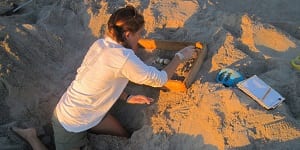UCF Marine Turtle Program Attracts & Inspires
 The UCF Marine Turtle Research Program attracts some of the best biology students from across the nation thanks to the groundbreaking work of its founder and the hands-on experience students get at the most important turtle nesting beach in North America.
The UCF Marine Turtle Research Program attracts some of the best biology students from across the nation thanks to the groundbreaking work of its founder and the hands-on experience students get at the most important turtle nesting beach in North America.
After getting the UCF experience, students go on to work in the field with government agencies, such as the U.S. Fish and Wildlife Service and NOAA, as policy advisors, university professors and conservation biologists for national and international nonprofit agencies.
The common thread is their experience with the turtle group, founded by now retired professor Llew Ehrhart. His work establishing and collecting sea turtle nesting data was the reason a 21 kilometer stretch of beach from south of Indialantic to the Sebastian Inlet State Park in Melbourne Beach was made into the Archie Carr National Refuge in the 1990s. It is recognized as the most important beach on the continent for sea turtles. Although retired, Ehrhart – called Doc by his students — continues to be a presence on the beach and on the water with turtles he first fell in love with in the 1960s.
“I selected UCF in order to work with Doc,” said Kendra Cope, a student pursuing a master’s degree. Originally from Texas, she moved to Florida to study marine life. “He is a legend in the sea turtle community. He is filled with endless knowledge and wisdom. Because of this I did not want to even apply to any other graduate programs.”
Chris Long, a PhD candidate, concurs.
“UCF is my school because of the turtle program specifically,” he said. “There is no better place to conduct turtle research. And now Kate is adding a whole new element to the program, it is even more exciting.”
Assistant professor Kate Mansfield took over UCF’s turtle program last fall. While Ehrhart created a legacy program that has given the turtle community historic information about the nesting behavior of threatened and endangered turtles, Mansfield’s research brings new perspectives on the in-water behavior of adults, juveniles, and in particular, the sea turtles’ “lost years.”
The “lost years” refer to the time after turtles hatch and head to sea where they remain for many years before returning to near-shore waters as larger sub-adults or juveniles.. The time period is often referred to as the “lost years” because not much is known about it. Mansfield is on the cutting edge of research in this area having developed a way to place satellite-tracking transmitters on these young yearling turtles. . She’s been studying these turtles for the past several years as they travel to deep waters in the Atlantic and the Gulf of Mexico.
As part of the Marine Turtle Research Group team, students get experience learning about the entire life cycle of turtles. The techniques students learn also apply to the study of other creatures from endangered snakes to dolphins.
Students spend months on the Brevard County beaches tagging and collecting information about sea turtles, which lay their eggs along the shoreline in the wee hours of the morning. The students also capture juvenile turtles that call the Indian River Lagoon home, examining the overall health of all turtles in the area. The students endure humid weather, biting bugs and long days to collect the data that provides policy makers with information to determine how to best preserve the three species of sea turtles that call Central Florida home.
Unlike some programs, the turtle group is not the exclusive arena of graduate students. Those who are truly interested and commit to the long hours can get access during their UCF career.
“I actually began my career with the UCF Marine Turtle Research group as an [undergraduate] intern in 2011,” said Ryan Chabot, who is now pursuing a master’s degree. “I liked the work so much that when it came time to make the decision of where to pursue my graduate education, I chose to remain right here.”
Chabot will be looking at how toxins and other environmental factors can impact the health and reproductive success of sea turtles.
None of the students in the program are taking on light topics for their graduate degrees. Long is looking at the management of green turtle populations in the face of climate change, while Cope will be looking at the economic impact of sea turtle eco-tourism on and around the Archie Carr refuge.
For Cope, the research has to tie into real life.
“I want to be someone who changes environmental protection for the better,” she said.
Students say there is no better ambassador or inspiration for conservation biology than the majestic turtles and no better place to learn than UCF’s long-standing program in Brevard County.
“Working in the field is an awesome experience,” Long said. “The first time you crawl behind a nesting turtle, red headlamp strapped to your head, and watch her lay her clutch of over 100 eggs is a remarkable experience. But the best part about it is this: it never gets old. The 100th time is just as exciting, because each time you spot something new and interesting.”
